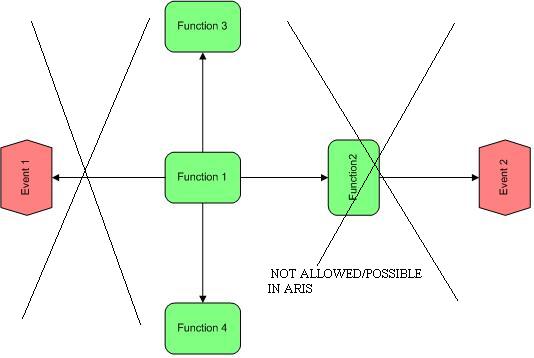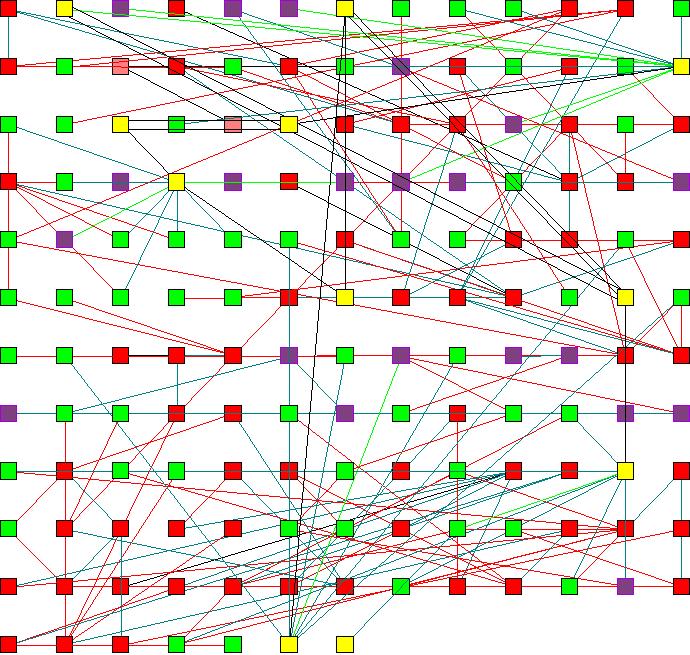...continued.....(continued from previous article)
Number#6: Welcome to the rotation-free world of ARIS
Yes, I know, this lack of support or lack of vision from developer should be in TOP 5 annoyance of ARIS but I save it for this article.
Face it, even VISIO (from version 1997) support rotation of both objects and text. This is also supported in netViz from CA (which is a network documentation tool but can be used in other domain). I am not sure why these rotation are not allowed or supported in ARIS. Sometime during modeling of EPC or developing Application Inventory, models are cramped for space, which can be easily avoided if rotation is supported. See the below picture for illustration:
(if someone knows work around for this, please post this in the comment section of this article)
Number#7: No way to hide assignment symbol to one object in a model (or lack of simple way)
Problem Scenario: In a model, there are many objects with different assignments to the models, I want to hide assignment symbol of one object. You can double click on object as shown below:
Do not confuse yourself, even if ARIS says "Hide Assignment" it means something else. The procedure above does something else (something else then Hiding the Assignment). Refer to the comments @ Rick Bosworth (honestly I do not know, in real world how many models will survive the pre-requisite condition which was mentioned by @ Rick Bosworth to perform the procedure).
Now the next thing, you will face is the ARIS refusal that object needs to meet certain condition, again refer to comments @Rick Bosworth for pre-req information which is explained much better then ARIS help.
Number#8: Automatic Layout or automatic annoyance
If am sure, you have not tried the automatic layout. Some tools support cool layout, i mean you can select the objects on the model and apply different layout (circle, rectangle, mash etc). These tools utilize sophisticated object placement algorithms which are publicly available.
Circle Layout
Rectangle Layout
The following layout is supported in ARIS, you can go to Arrange --> Layout to playaround
Now this is the output from ARIS, I copied 50 objects from explorer, if you do this no need to worry, ARIS will automatically apply ladder layout (you have to figure out what is the use of this layout), then you can try Arrange --> Layout option and you will get Line Arrangement (your object will be arrange in a line and making your model the world largest model in terms of the width).
Number#9: Limitation of built-in editor
Depicted in the below picture:
Number#10: How to find objects within a model?
Let say, you have 100 objects within a model (may happen in application inventroy model, process map model etc.). You want to locate particular object, there is no way to see, how many objects are within a model (rumour has it that ARIS developers have done something about this problem!!!!!!!!!!!!). Yeah I was right, there is a way to list objects occurence within a model, see the comment @ Mr. Rick Bosworth.
(....continued.....)



.JPG)












Rick Bosworth on
#6 I suppose you could create new symbols which are flipped as a work around but it seems a lot of work.
#10 If you turn on Navigation in Designer you can go to the Occurrences tab and see all of the objects in the model. Click on one and ARIS navigates so that the object is visible. You can also get a simple list of objects referenced by a model in explorer by selecting the model and changing to the Objects tab.
#7 Yes it is true that IDS has a habit of creating their own terms for things and then not using them consistently (By the way I hope this will make your list, especially the changes in the names of things between, Architect, Publisher and IT Inventory).
First you must understand that the Hide functionality is removing objects from the model and moving them into a separate model which will become assigned to the original object. It does not remove the assignment icon.
If it helps I believe the following "translations" to be true:
1) A "structurally relevant object" is one that is part of the primary flow of the model. So for instance, Event-Function-Event all are structurally relevant. However, People and Applications attached to a function are not because they supporting resources and not part of the flow of the process.
2) This is saying that all of the objects related to the selected object must be valid content for the new model that will be created. In the example above the People and Application objects would be removed and placed in the new model, presumably in this case a Function Allocation Diagram.
3) This one seems pretty clear.
Perahps someone from IDS Scheer can provide more explanation or correct me if I'm wrong.
Rick